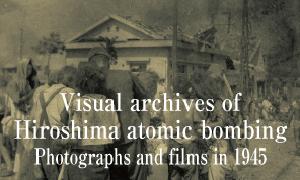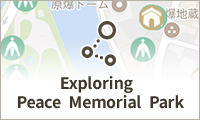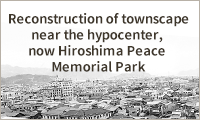Hiroshima University to study impact of peace museum’s exhibits on children; Stress reaction study for exhibits in planned children’s space
Sep. 5, 2025
by Aya Kano, Staff Writer
The Hiroshima Peace Memorial Museum located in the city’s Naka Ward and Hiroshima University are studying how personal belongings and photographs displayed at the museum affect children’s states of mind. The results will be used for planning a new children’s exhibition space scheduled to open at the museum by fiscal 2028. The study measures how stress reactions caused by fear and empathy change between immediately after viewing the exhibits and one month later.
The survey involves 10 elementary school students, nine junior high school students, and 10 high school students from the city. After visiting the museum, participants rate their reactions to 17 exhibits, including personal belongings, photographs, and atomic bomb drawings, on a four-point scale for feelings such as “frightening,” “likely to remember later,” or “felt pity,” and they are interviewed to give reasons. The same questions will be asked one month later to determine how much these reactions remain.
Yuka Kamite, an associate professor specializing in clinical psychology at Hiroshima University’s Graduate School, and other experts from Hiroshima Shudo University and Hijiyama University will analyze the results. Associate Professor Kamite said, “Some children find the exhibits too stimulating to view, while others want to understand them more deeply. If we can confirm differences between age groups and the relationship with children’s individuality, we can obtain materials for judging what exhibits are appropriate.”
As the number of visitors to the museum has been increasing sharply, it difficult for students on school trips to fully study the exhibits. The city plans to establish a children’s space on the basement level of the museum’s East Building, and an advisory committee of experts has been discussing its exhibition content. While some committee members say it is necessary to present horrific scenes to children as well, others argue that the psychological burden on them must be considered.
The survey results will be reported at a future meeting. Toshihiro Toya, deputy director of the museum, said, “It’s natural to be scared of the atomic bomb and war, but we don’t want children to avoid facing them just because they don’t want to be frightened. We hope the survey results will help us determine how to convey the reality of the damage to children.”
Keywords
New exhibition space for children to be established at Hiroshima Peace Memorial Museum
The new children’s exhibition space will cover a total of about 500 square meters of the Meeting Room 1, Meeting Room 2, and Special Exhibition Room on the first basement floor of the East Building of the museum. An advisory committee will hold six meetings to discuss the content of the exhibition by the end of fiscal 2026. The 11 members of the committee include specialists in education and psychology and A-bomb survivors. Renovation work will begin in fiscal 2027, and the new exhibition space will open in fiscal 2028.
(Originally published on September 5, 2025)
The Hiroshima Peace Memorial Museum located in the city’s Naka Ward and Hiroshima University are studying how personal belongings and photographs displayed at the museum affect children’s states of mind. The results will be used for planning a new children’s exhibition space scheduled to open at the museum by fiscal 2028. The study measures how stress reactions caused by fear and empathy change between immediately after viewing the exhibits and one month later.
The survey involves 10 elementary school students, nine junior high school students, and 10 high school students from the city. After visiting the museum, participants rate their reactions to 17 exhibits, including personal belongings, photographs, and atomic bomb drawings, on a four-point scale for feelings such as “frightening,” “likely to remember later,” or “felt pity,” and they are interviewed to give reasons. The same questions will be asked one month later to determine how much these reactions remain.
Yuka Kamite, an associate professor specializing in clinical psychology at Hiroshima University’s Graduate School, and other experts from Hiroshima Shudo University and Hijiyama University will analyze the results. Associate Professor Kamite said, “Some children find the exhibits too stimulating to view, while others want to understand them more deeply. If we can confirm differences between age groups and the relationship with children’s individuality, we can obtain materials for judging what exhibits are appropriate.”
As the number of visitors to the museum has been increasing sharply, it difficult for students on school trips to fully study the exhibits. The city plans to establish a children’s space on the basement level of the museum’s East Building, and an advisory committee of experts has been discussing its exhibition content. While some committee members say it is necessary to present horrific scenes to children as well, others argue that the psychological burden on them must be considered.
The survey results will be reported at a future meeting. Toshihiro Toya, deputy director of the museum, said, “It’s natural to be scared of the atomic bomb and war, but we don’t want children to avoid facing them just because they don’t want to be frightened. We hope the survey results will help us determine how to convey the reality of the damage to children.”
Keywords
New exhibition space for children to be established at Hiroshima Peace Memorial Museum
The new children’s exhibition space will cover a total of about 500 square meters of the Meeting Room 1, Meeting Room 2, and Special Exhibition Room on the first basement floor of the East Building of the museum. An advisory committee will hold six meetings to discuss the content of the exhibition by the end of fiscal 2026. The 11 members of the committee include specialists in education and psychology and A-bomb survivors. Renovation work will begin in fiscal 2027, and the new exhibition space will open in fiscal 2028.
(Originally published on September 5, 2025)








